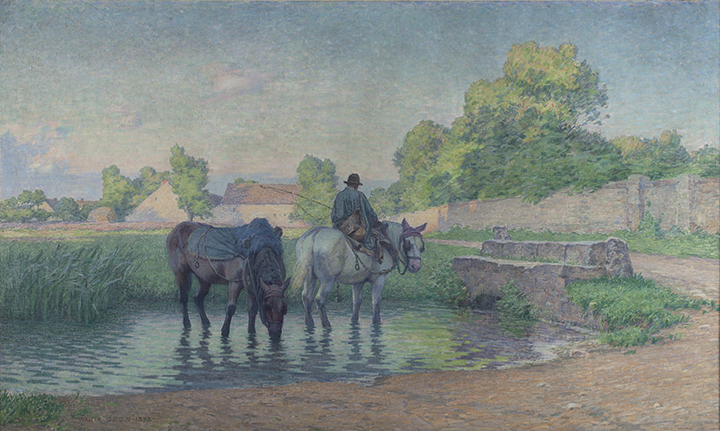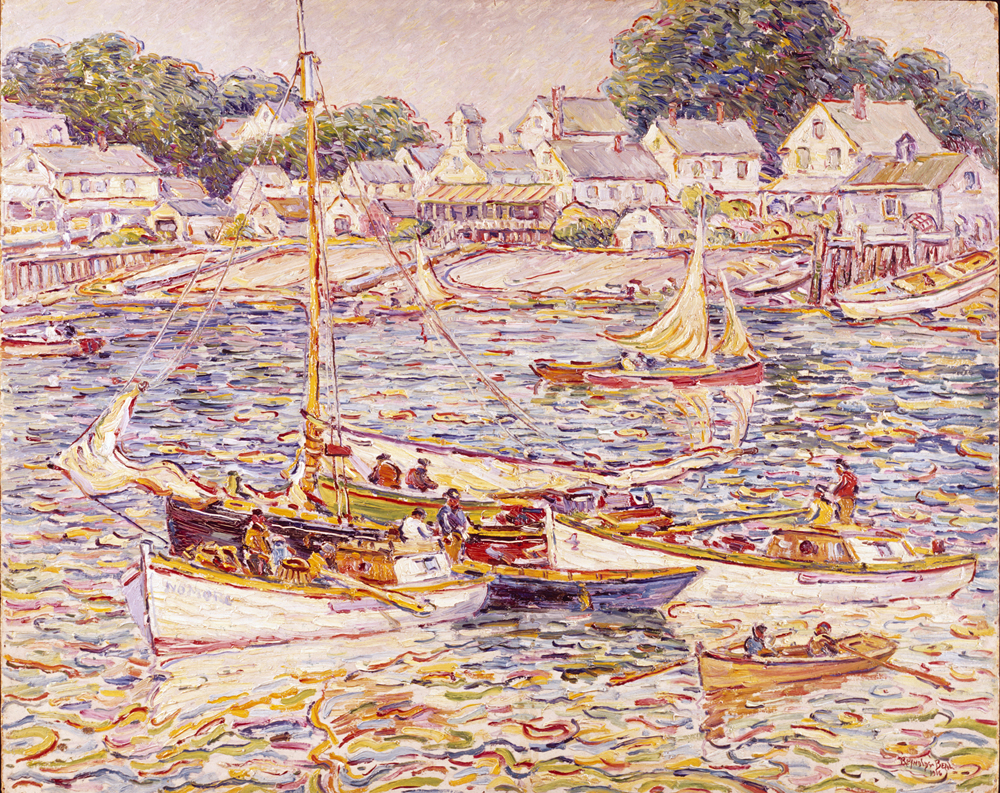

While the museum is closed, we’ve asked our docents to take us on “virtual docent’s tours,” showing us digitally some of their favorite works. Mary Rowin has been a docent since 2004.
How did you become a docent?
I was member of the Madison-area chapter of the Embroiderers’ Guild, and one of my friends in that organization was a docent. She was recruiting volunteers to help during a quilt exhibit, and the museum needed people who would help keep eager quilters from touching the works. I volunteered and discovered I loved working in the galleries. When the opportunity arose to train to become a docent, I applied immediately. I took art history classes in college and studied art and art history on my own during many years of international travel. My husband says I’ve never met a museum I didn’t like…or enter!
When you’re conducting a tour of the permanent galleries, which pieces do you always show your guests?
When I give tours, I first find out whether the tour group has any special requests. If so, I gear the tour accordingly. On my own, for a Docent’s Choice tour, I like to select objects to compare. Recently, I have enjoyed pairing Scene at Fleury, France from 1893 by Walter Griffin with Provincetown Waterfront, from 1916 by Reynolds Beal. I also enjoy comparing Dawn’s Wedding Chest from 1959 by Louise Nevelson with Untitled #1378 (Zelda Fitzgerald) by Petah Coyne, 1997-2013.
Why do you include these particular pieces in your tours?
With Scene at Fleury, France I let people look at it while I ask what they notice first. What do they think about the colors? What time of day is it? We discuss the narrative next. Why are the horses looking at us? What is the man doing?

Walter Griffin, (American, 1861-1935), Scene at Fleury, France, 1893, Oil on canvas, 44 1/2 x 73 1/2 in., Thomas E. Brittingham Fund and Elvehjem Museum of Art General Endowment Fund purchase, 1979.77
Walter Griffin, an American who lived in Fleury between 1889 and 1893, did not mix paint on his palette. Rather, he picked up two colors on the same brush and mixed them on the canvas. We look at the water in the pond to see how his technique makes the water shimmer or vibrate. I ask visitors about the mood of the painting and how it makes them feel, and where they would go to paint outdoors.

Reynolds Beal, (American, 1867-1951), Provincetown Waterfront, 1916, Oil on artist’s board, 28 1/4 x 35 1/2 in., Friends of the Elvehjem Museum of Art purchase, 1979.125
Then we look at Provincetown Waterfront. Beal works rapidly and lays down thick swatches of bright pigments that capture light reflections. The overall effect is a mosaic of color. Immediately, people comment that it is vibrant, busy and makes them feel almost nervous in comparison to the calm feeling of the Fleury painting.
Dawn’s Wedding Chest is a small piece from a large room full of similar wedding constructions—chapels, a cake, chest, mirror, pillow, attendants, bride and groom—that filled a gallery in the Museum of Modern Art in 1959. Nevelson wanted to keep the exhibit together, but no museum was interested in buying the whole thing, so she destroyed most of it, cannibalizing pieces for other works.

Louise Nevelson, (American, b. Ukraine, 1899-1988), Dawn’s Wedding Chest, 1959, Wood, paint, 27 x 15 x 6 in., Terese and Alvin S. Lane Collection, 2012.54.41.2
I ask visitors to describe what they see and how the piece was assembled. I tell them about the larger MOMA exhibit and something about Nevelson’s story—that her father was a woodcutter who opened a junkyard and that she enjoyed beachcombing and placed found objects in boxes under her bed.
I point out other Nevelson pieces in the gallery, most of which are painted black. I ask why Dawn’s Wedding Chest is white. Most people associate white with weddings, of course. I tell them that when Louise married Charles Nevelson, he thought he was marrying a society wife; she wanted to be an artist. Louise felt she lost something being married to a well-to-do businessman. She found herself in marriage to art, so the white paint represents hope, possibility and new beginnings.

Petah Coyne, (American, b. 1953), Untitled #1378 (Zelda Fitzgerald), 1997-2013, Mixed media including silk flowers, wax, acrylic paint, pearl-head pins, artificial pearls, cast wax statuary figure and hand sculptures,ribbon, knitting needles, fabric, thread, wire, horse hair, drywall, plaster, filament, rubber, steel, wood, 81 3/16 x 35 3/4 x 35 3/4 in., Joen Greenwood Endowment Fund purchase, 2018.39a-b
The piece I like to compare with Dawn’s Wedding Chest is the construction by Petah Coyne, Untitled #1378 (Zelda Fitzgerald). There is a lot to see in this work, so I ask visitors to spend some time looking and then share what they have seen: white candles, ribbons, pearls, flowers, a Madonna and hands. I ask what visitors think the artist’s process is and about the wax that holds it together.
I tell them that Petah Coyne likes to dedicate her works to under-recognized female artists and that this piece is dedicated to Zelda Fitzgerald, F. Scott Fitzgerald’s wife. The couple were Roaring Twenties celebrities whose tumultuous relationship was marked with drink and violence. I tell visitors that Zelda was a talented artist in her own right, a painter, dancer and writer, and that F. Scott used her story and diaries in his works. The 1929 stock market crash ended the party. Zelda was diagnosed with schizophrenia and spent much of the remainder of her life in mental institutions. There are many hands hanging from ribbons in the work. What do they represent? Zelda grasping for help.
I end by asking how communities honor people. Visitors share many examples such as statues, plaques, memorials and parades. Then I ask how they would honor someone they admire. They appreciate how an artwork can become personal; how it might suggest something they could do in their own lives.
Is there anything you’d like to pass along to readers in this difficult time about art and the solace it can provide, or about the Chazen in general?
The Covid-19 virus has hit the world with astounding speed. Adapting to stay-at-home orders is difficult but not impossible and can foster a bit of creativity as we peer into pantries and boxes of art supplies for ideas. The hardest thing for most is the uncertainty: how long will this go on, will these measures work, will we be ok? Works of art in museums like the Chazen provide respite from the anxiety.
Here is a work that transports the viewer to another time, another whose colors are joyful, one that generates laughter or sooths fears. One of my great joys as a docent has been to return to the Chazen after traveling and walk through the galleries, greeting familiar works like old friends and seeing new works that are a surprise and pique my curiosity. It’s like things will be when this crisis is over—when we see old friends and have new experiences again.